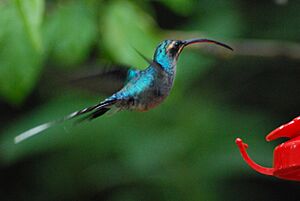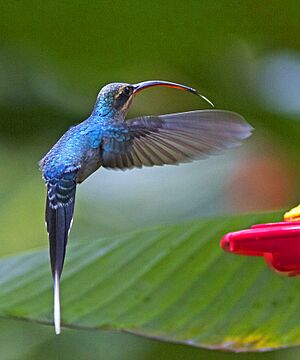Green hermit facts for kids
Quick facts for kids Green hermit |
|
|---|---|
 |
|
| Conservation status | |
| Scientific classification | |
| Genus: |
Phaethornis
|
| Species: |
guy
|
 |
|
The green hermit (Phaethornis guy) is a beautiful, large hummingbird found in parts of Central America and South America. These amazing birds live in countries like Costa Rica, Panama, Venezuela, Trinidad, and the northern Andes mountains in eastern Peru. They are known for their bright colors and unique calls.
Contents
About the Green Hermit
The green hermit is a fairly large hummingbird. It measures about 13.5 centimeters (around 5.3 inches) long. It weighs about 6.3 grams, which is less than a quarter of an ounce!
What They Look Like
The male green hermit is mostly a dark green color. Its lower back, called the rump, has a pretty blue-green shine. It has a dark stripe that goes through its eye, like a mask. Above and below this stripe, there are light, yellowish-brown lines. There's also a light stripe down the middle of its throat.
The tail feathers in the middle are quite short for a hermit hummingbird. They have white tips. Males wiggle these tail feathers when they are trying to attract a mate at special gathering spots called leks. The bird's bill (beak) is long, reddish, and curves downwards.
The female green hermit looks a bit different. Her underside is a sooty gray color instead of green. She also has an even longer bill and a much longer tail than the male.
Sounds They Make
The green hermit has a loud call that sounds like "zurk." When males gather at their lekking spots to find a mate, their "song" is a repeated "swark" sound.
Where They Live
The green hermit hummingbird lives in different parts of Central and South America. There are two main groups, or subspecies. The Phaethornis guy guy group lives in Venezuela and Trinidad. The P. g. apicalis group lives in the western mountains of the Americas. This western group is a bit smaller, and the male and female look more alike.
Their Home Environment
These hummingbirds like to live in the undergrowth of forests. They often stay near water and prefer hilly areas. They especially love old, untouched rainforests and wet forests found in the mountains.
Even though they can live in places where people have changed the land a little, like small farms, they try to avoid forests that have grown back after being cut down. They prefer their natural, undisturbed homes.
In the mountains of Colombia, green hermits have been seen at heights from about 650 to 1,750 meters (about 2,100 to 5,700 feet) above sea level. The forests they live in usually have tall trees, about 25 meters (82 feet) high. These forests often have many plants growing on other plants, like epiphytes and hemiepiphytes.
Green Hermit Behavior
Feeding Habits
The green hermit's main food is nectar, which they get from many different kinds of flowers. They also eat some small insects. They seem to prefer flowers that are about 30 to 50 millimeters (1.2 to 2 inches) long and 2 to 7 millimeters (0.08 to 0.28 inches) wide. However, they will sometimes visit much longer or shorter flowers too.
In Costa Rica, some of their favorite flowers include yellow jacobinia, spiral ginger, and various types of Drymonia plants. They also visit many other kinds of flowers, especially those from the Gesneriaceae, Heliconiaceae, and Acanthaceae families.
Reproduction and Life Cycle
As mentioned before, male green hermits gather at special places called leks. This is where they perform displays to attract female hummingbirds for mating. In the Colombian mountains, these active leks have been seen between September and November, which means this is their main breeding season.
The female green hermit lays just one egg. She builds a cone-shaped nest that hangs underneath a large leaf, usually over water. The egg takes about 17 to 18 days to hatch. After hatching, the young bird stays in the nest for another 21 to 23 days before it is ready to fly.



